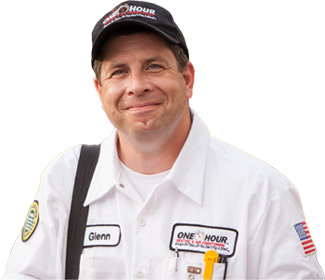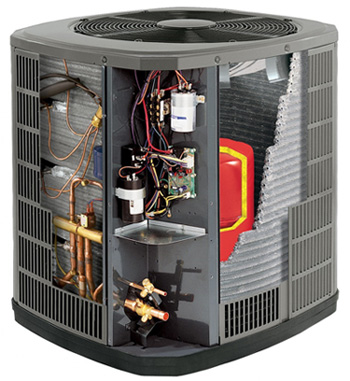
If it heats or cools, One Hour can fix/install it.
If you don’t have a gas bill in the winter, more than likely you have a heat pump. We fix and install hundreds of heat pumps every year in all makes and models (see the installation system we’ve perfected.) They’re great for Hampton Roads’ relatively mild climate because they effectively replace your air conditioner and furnace and can cut 30% to 50% off your monthly bills. AC/Furnace systems see dramatic gas bill increases during the winter.

Heat Pumps, Air Conditioners & Furnaces – Similar but Not the Same
A heat pump’s name comes from its ability to “pump heat” into or out of your house.
A Heat Pump Heats and Cools
Consisting of an air handler and a heat pump, it moves heat outside in the summer and then switches to move heat inside in winter. It replaces your furnace and air conditioner. To the untrained eye, it looks like you only have an AC unit. What you actually have is a souped-up air conditioner that can work in reverse.
How Heat Pumps Work
You can add a heat pump to an existing furnace by replacing the air conditioning side of the system with a heat pump. This makes it a “Dual-Fuel” system, which is far more efficient than a gas-powered AC/Furnace system. In “Dual-fuel” systems, the heat pump is the initial heat source until the temperature gets too cold outside. At this point the furnace takes over, giving you the best of both systems.
Because a heat pump also performs air conditioning in the summer, it takes the place of an air conditioner. It uses the same refrigerant lines, electrical setup, ductwork, and air mover that the air conditioner was using.
The difference between a Heat Pump and other HVAC systems
Technically a geothermal system is a heat pump. Instead of taking heat from outdoor air it uses water heated from the earth. This water is usually a consistent 55 degrees while outdoor air varies from below freezing to 100 degrees.
Because of the consistency of the earth’s temperature, compared to the variation in air temperature, geothermal systems are even more efficient than heat pumps.
The Cost of Installing and Operating a Heat Pump
$5000 to $15,000 is the total range of a heat pump system’s cost. It’s generally less expensive than a gas AC/Furnace system or a geothermal system to install. They also can last up to 12+ years and sometimes last 20+ years if yearly maintained with One-Hour’s 3-Way Guaranteed Tune-Ups (included FREE as part of a Comfort Club membership)
These are the items that effect the cost:
- Current electrical system’s capacity – might need new electrical system w/ more capacity
- Current refrigerant line size – might need new lines
- Current thermostat wire’s capacity – might need new wires
- Equipment access size – might need to make more room
- Efficiency of new system – more efficient systems cost more but save you more
- Comfort controls of new system
- Air quality controls.
Installation is the Most Important Part of Heat Pump Savings
Because Virginia doesn’t require a permit to be pulled when replacing a heat pump system, it’s the easiest for businesses to take short cuts on. Those can add up to increase your utility bills 50% and cut the system life in half, before it ever starts.
One Hour’s Perfect Heat Pump Installation Process
- The “install” actually begins with finding the perfect-sized system for your home. A Comfort Advisor does this via a 60-90 minute “Comfort Survey and Engineering Analysis”. It not only calculates your home’s energy loss, but discovers what’s most important to your comfort and budget.
- Once you’ve selected the best unit for you, One Hour always:
- Replaces the electrical whip and disconnect box for the outdoor unit
- Installs a new, leveled slab for the heat pump to sit on
- Insulates all outdoor refrigerant lines
- Provides the “Ceiling Saver Switch”, an automatic emergency shut off to prevent flooding in the event that condensate lines back up.
- Attaches a new trap kit to make sure condensate doesn’t back flow into your heat pump
- Calibrates your heat pump based on duct size to make sure air flows as smoothly as possible.
- Installs a brand new, programmable thermostat with every heat pump system we install.
All of One Hour’s extra little steps add up to save you as much money as possible from the moment you turn your heat pump on and as long as it keeps you comfortable.
